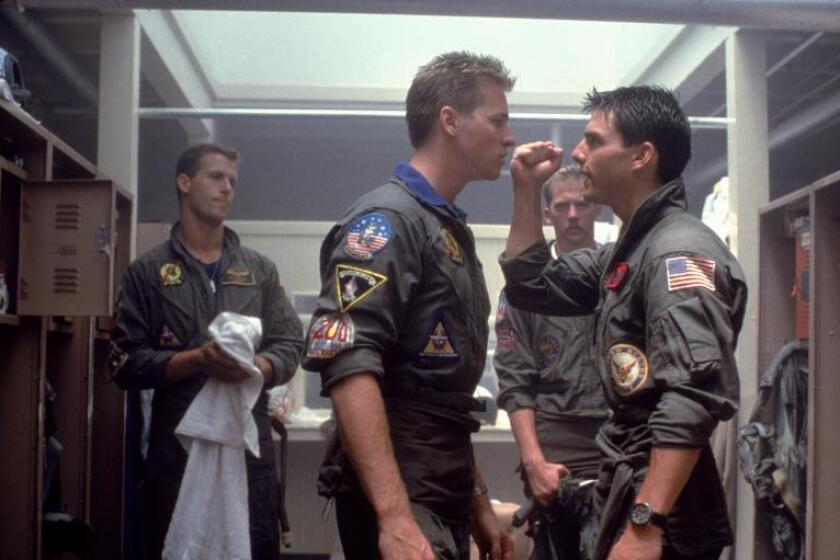Community Unveiled in Mural
- Share via
What began as a safety crusade for stop signs and security cameras took a turn for the beautiful Saturday, with the unveiling in Los Angeles of a mural that has helped a West Adams neighborhood discover itself.
The event was held on Budlong Avenue just south of Washington Boulevard, where a series of shooting deaths two years ago inspired the creation of a neighborhood association.
At the center of that effort was Yvette Jones, 37, a mother whose concern for the safety of her two sons led her to hold the group’s first meeting in her own backyard.
Since then, the Budlong-Juliet-Catalina Neighborhood Assn. has successfully lobbied city officials for assistance in making the area safer and cleaner.
Now, with the aid of a local artist, the community has created its own self-portrait, 20 feet high and 80 feet long.
“It’s such a relief,” Jones said when the blue plastic tarpaulins covering the mural were finally loosed Saturday to cheers and applause, nearly six months after the project began.
Although many people were seeing the completed work for the first time, Jones said the mural had long ago begun to fulfill its purpose. “It’s begun a dialogue here in the community,” she said.
Stretched across a bakery wall that had to be sandblasted free of layers of graffiti, the mural is centered on the image of a sari-wrapped man and woman, their bodies framed by leaves of the healing aloe plant.
Like the other characters depicted, the images are based on local people.
“I expect to live another 25 years, but hopefully after I’m gone, this will help people remember me,” said Lucius Jackson Jr., 74, who has lived in the area since 1958.
Sameerah Samad Muhammad, 63, has worked down the street from the mural at the Rosedale Cemetery for eight years, and she said it would brighten her drive home every evening.
“It’s just lovely,” she said. “It’s such a humbling thing and such an honor.”
The mural’s name, “Evolution of a Community,” summarizes the story of its creation.
Two years ago, the neighborhood, on the flanks of the 10 Freeway, was a wreck. Vagrants loitered in the bushes. A tunnel under the freeway was choked with refuse. Cars careened down local streets, heedless of the children playing there.
“It was horrible,” said Taquedia Brown, 14, who lives in an apartment building on West 28th Street. “There were always people smoking weed and tagging up the apartments.”
But it was a rash of murders -- six in three months -- that pushed Jones into action. She’d grown up in the area and returned with her two teenage sons. The killings convinced her that things had to change.
Jones called the meeting in her backyard, which had a cinderblock wall scarred with graffiti. On that day, Aug. 24, 2002, the neighborhood association was born.
They began with the basics. When the city refused their request to place stop signs at local intersections, they asked again, and again, until the signs were erected. A cleanup of the Bud- long Tunnel was organized, and then the group lobbied for security cameras at both ends of the tunnel. Next on the agenda were chain-link fences along the freeway.
A baker approached the principal of an elementary school across the street, frustrated by his losing battle against graffiti on the wall of his business. By that time, the word was out, and he was directed to Jones.
Jones approached Tomashi Jackson, a local artist who had returned to the area after moving to San Francisco and was working as an apprentice with muralists Juana Alicia and Susan Cervantes.
While working in San Francisco’s troubled Hunter’s Point neighborhood, Jackson, 24, had drawn a sketch inspired by her desire to create an uplifting image for children.
Jackson saw West Adams, like Hunter’s Point, as “a wounded area” and decided to adapt her sketch for the bakery wall.
Jones and Jackson were awarded a $10,000 grant from the Los Angeles Department of Public Works, and, in November 2003, work began.
During the early stages of the project there were stares of suspicion from some locals, but as Jackson spent more time on the mural, often perched on a 20-foot scaffold, curiosity prevailed.
“It wasn’t much of a neighborhood at first, but after a while people would start to congregate and just talk,” said Dru Farnham, who has lived in the area since 1988.
There was the Latina grandmother who shuttled her two granddaughters everywhere, but always stopped to admire Jackson’s progress. And the father, his hair in cornrows, with a fondness for a puffy white down jacket. And the baldheaded elderly man with an air of dignity.
Jackson began taking breaks from painting to take snapshots of people, then incorporating their images into the mural.
“Some people just stood out,” she said.
They were African American, Latino, Ethiopian, and they didn’t all speak the same language, but Jackson saw that the mural was something everyone could relate to.
As Jackson was putting finishing touches on it in the predawn hours Saturday, a man she had seen but never spoken to stopped to talk. She learned he was a father of six, a former soldier from El Salvador. He wanted to know if there would be music at the unveiling.
“He said [the mural] made him want to dance and party,” Jackson said. “He said he had never danced before.”
More to Read
The biggest entertainment stories
Get our big stories about Hollywood, film, television, music, arts, culture and more right in your inbox as soon as they publish.
You may occasionally receive promotional content from the Los Angeles Times.










